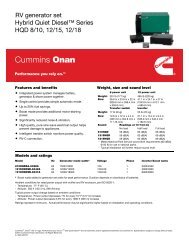Air Brake Manual
Air Brake Manual
Air Brake Manual
Create successful ePaper yourself
Turn your PDF publications into a flip-book with our unique Google optimized e-Paper software.
Up to this point, the system discussed is the air brake<br />
system of a truck or tractor. If a trailer was coupled to<br />
a truck or tractor, the brakes of the trailer would have<br />
to be operated from the truck or tractor.<br />
In the following pages the power unit of a combination<br />
vehicle will be referred to as a tractor.<br />
Glad Hands<br />
This term refers to the coupling device used to<br />
connect the control (service) and supply (emergency)<br />
lines of the trailer to the tractor. These couplers<br />
<strong>Air</strong> line<br />
Rubber seal<br />
<strong>Air</strong> line<br />
connect together and lock in position. They have<br />
rubber gaskets that prevent air from escaping at the<br />
connections.<br />
Before connection is made, couplers should be clean<br />
and free of dirt and grit. When connecting the glad<br />
hands, start with the two gaskets together and the<br />
couplers at a 90° angle to each other. A quick snap<br />
downwards will join and lock the couplers. Vehicles<br />
equipped with “dead-end” couplers should use them<br />
whenever the vehicle is used without a trailer to<br />
prevent water and dirt from entering the coupler and<br />
lines.<br />
If the unit is not equipped with dead-end couplers,<br />
the glad hand of the control (service) line can be<br />
locked to the glad hand of the supply (emergency)<br />
line to keep water and dirt from entering the unused<br />
lines. The cleaner the air supply is kept, the less<br />
chance of brake problems.<br />
Glad hands and lines should also be secured to<br />
prevent the lines from chafing against vehicle<br />
components or bouncing off the vehicle. This could<br />
seriously damage the glad hands or lines.<br />
Application Line<br />
The application line is referred to as a control<br />
(service) line. This line is connected to the foot and<br />
hand valve. When the driver depresses the foot<br />
valve treadle application air will be delivered to the<br />
tractor brake chambers and to the trailer brake<br />
chambers. When the driver releases the foot valve<br />
treadle, the application air to the trailer brake<br />
chambers must return to the foot valve to be<br />
exhausted to the atmosphere.<br />
The disadvantages of this system are:<br />
· if the trailer broke away from the tractor, the<br />
trailer would not have brakes.<br />
· if the control (service) line parted or ruptured, the<br />
trailer brakes would not be applied, and the<br />
application air would be lost from the tractor if the<br />
brakes were applied.<br />
· if the air pressure in the reservoirs is lost, there<br />
would be no way to apply the brakes of the tractor<br />
or the trailer.<br />
· the trailer brakes cannot be applied independently<br />
from the tractor and there is no way to set the<br />
trailer brakes when coupling to the tractor.<br />
· the application and release of the trailer brakes<br />
would be slower than those of the tractor.<br />
These disadvantages are overcome by the addition<br />
of the supply (emergency) line and valves discussed<br />
in the following pages.<br />
The illustration shows the piping of a unit with<br />
brakes applied, similar to the tandem axles of the<br />
tractor. Also with brakes applied, the trailer has<br />
tandem axles equipped with brake chambers.<br />
The application line has a “T” inserted between the<br />
foot valve (31) and the tractor’s relay valve (13). An<br />
air line has been connected from this “T” to the<br />
trailer by a set of couplers (glad hands) (20).<br />
38




